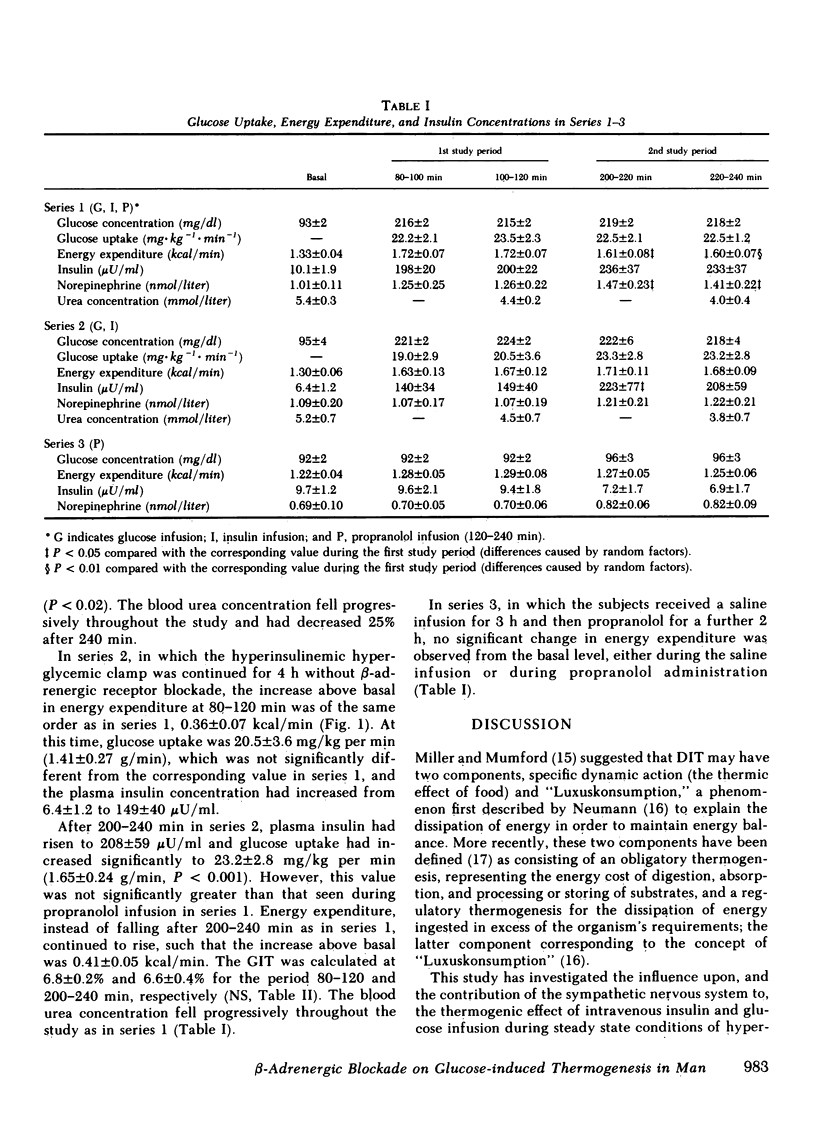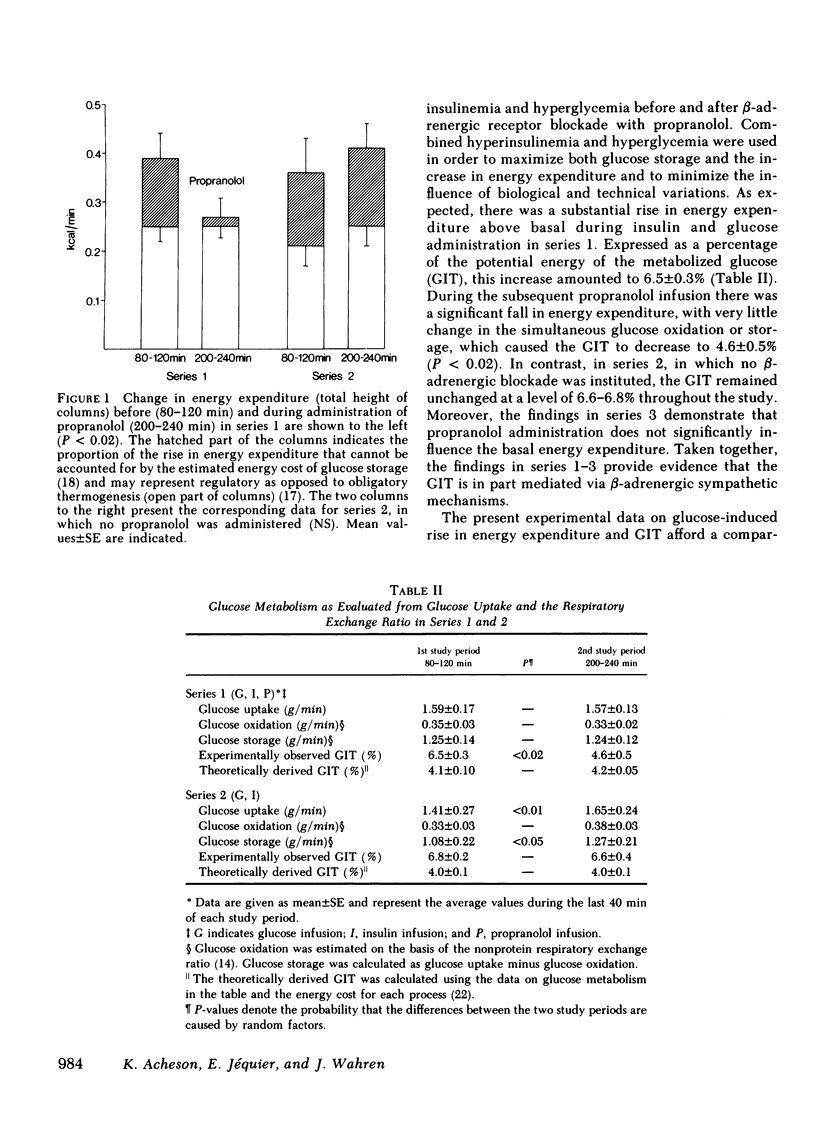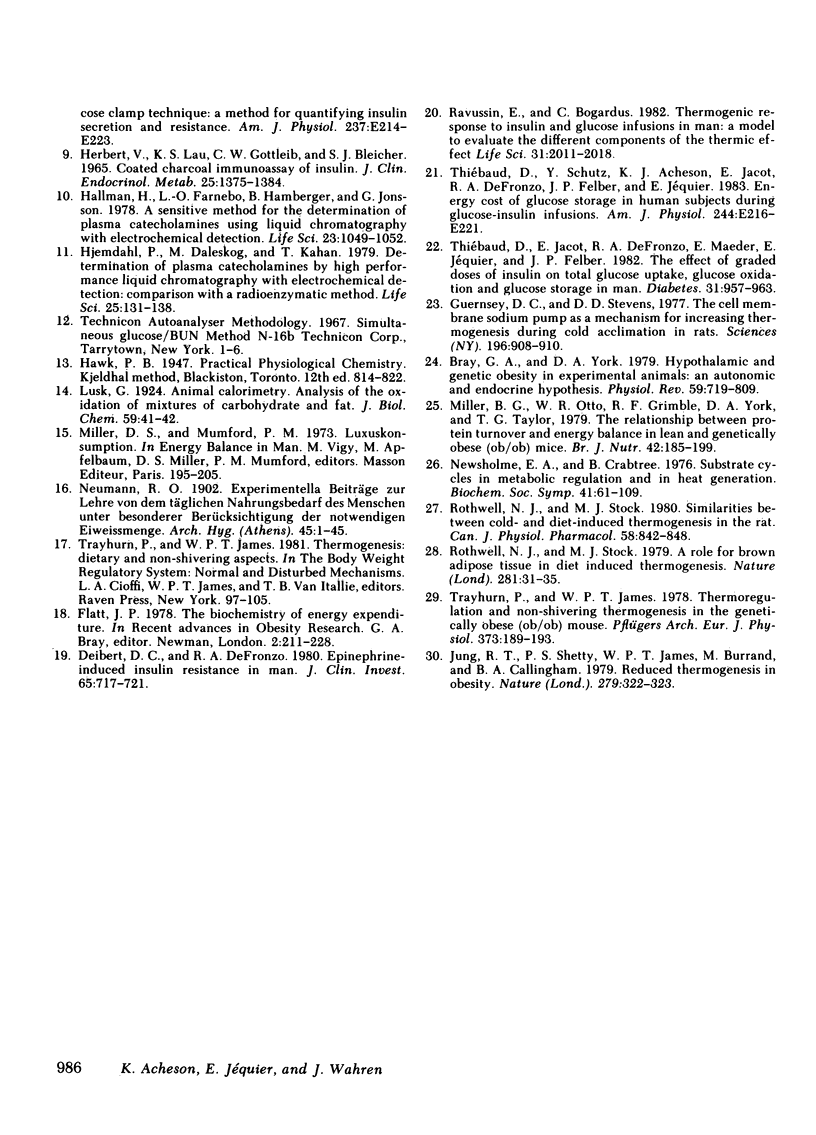Abstract
The role of beta-adrenergically mediated sympathetic nervous activity in the regulation of glucose-induced thermogenesis was examined in healthy male subjects. Respiratory gas exchange was measured continuously, using the ventilated hood technique, under conditions of hyperinsulinemia and hyperglycemia (glucose clamp technique, insulin infusion 1 mU/kg per min, glucose levels 125 mg/dl above basal) before and after beta-adrenergic blockade (i.v. propranolol, 3-mg bolus plus 0.1 mg/min for 2 h). After 2 h of insulin and glucose infusion in series 1, glucose uptake had increased to 23.5 +/- 2.3 mg/kg per min and insulin concentration to 199 +/- 21 microU/ml. Simultaneously, the energy expenditure had risen by 0.39 +/- 0.05 kcal/min above basal. After propranolol administration, glucose uptake did not change, while energy expenditure fell significantly, to a level 0.28 +/- 0.04 kcal/min above basal. The glucose-induced thermogenesis (GIT) was 6.5 +/- 0.3% before and 4.6 +/- 0.5% (P less than 0.02) after propranolol. In series 2, insulin and glucose infusion was continued for 4 h without propranolol administration. Glucose uptake rose (+12%) and insulin levels increased (+40%) between the 2nd and 4th h but energy expenditure and GIT remained unchanged. Subjects in series 3 received saline infusion alone for 3 h, at which time propranolol administration as in series 1 was added during a further 2-h period. No changes in energy expenditure were seen during saline or propranolol infusion. These data demonstrate the presence of a beta-adrenergically mediated sympathetic nervous component in glucose-induced thermogenesis in healthy human subjects. This factor may be of importance in the regulation of normal body weight in man.
Full text
PDF





Selected References
These references are in PubMed. This may not be the complete list of references from this article.
- Bray G. A., York D. A. Hypothalamic and genetic obesity in experimental animals: an autonomic and endocrine hypothesis. Physiol Rev. 1979 Jul;59(3):719–809. doi: 10.1152/physrev.1979.59.3.719. [DOI] [PubMed] [Google Scholar]
- DeFronzo R. A., Tobin J. D., Andres R. Glucose clamp technique: a method for quantifying insulin secretion and resistance. Am J Physiol. 1979 Sep;237(3):E214–E223. doi: 10.1152/ajpendo.1979.237.3.E214. [DOI] [PubMed] [Google Scholar]
- Deibert D. C., DeFronzo R. A. Epinephrine-induced insulin resistance in man. J Clin Invest. 1980 Mar;65(3):717–721. doi: 10.1172/JCI109718. [DOI] [PMC free article] [PubMed] [Google Scholar]
- Guernsey D. L., Stevens E. D. The cell membrane sodium pump as a mechanism for increasing thermogenesis during cold acclimation in rats. Science. 1977 May 20;196(4292):908–910. doi: 10.1126/science.860125. [DOI] [PubMed] [Google Scholar]
- Hallman H., Farnebo L. O., Hamberger B., Johnsson G. A sensitive method for the determination of plasma catecholamines using liquid chromatography with electrochemical detection. Life Sci. 1978 Sep 11;23(10):1049–1052. doi: 10.1016/0024-3205(78)90665-3. [DOI] [PubMed] [Google Scholar]
- Herbert V., Lau K. S., Gottlieb C. W., Bleicher S. J. Coated charcoal immunoassay of insulin. J Clin Endocrinol Metab. 1965 Oct;25(10):1375–1384. doi: 10.1210/jcem-25-10-1375. [DOI] [PubMed] [Google Scholar]
- Hjemdahl P., Daleskog M., Kahan T. Determination of plasma catecholamines by high performance liquid chromatography with electrochemical detection: comparison with a radioenzymatic method. Life Sci. 1979 Jul 9;25(2):131–138. doi: 10.1016/0024-3205(79)90384-9. [DOI] [PubMed] [Google Scholar]
- Jung R. T., Shetty P. S., James W. P., Barrand M. A., Callingham B. A. Reduced thermogenesis in obesity. Nature. 1979 May 24;279(5711):322–323. doi: 10.1038/279322a0. [DOI] [PubMed] [Google Scholar]
- Landsberg L., Young J. B. Fasting, feeding and regulation of the sympathetic nervous system. N Engl J Med. 1978 Jun 8;298(23):1295–1301. doi: 10.1056/NEJM197806082982306. [DOI] [PubMed] [Google Scholar]
- Miller B. G., Otto W. R., Grimble R. F., York D. A., Taylor T. G. The relationship between protein turnover and energy balance in lean and genetically obese (ob/ob) mice. Br J Nutr. 1979 Sep;42(2):185–199. doi: 10.1079/bjn19790106. [DOI] [PubMed] [Google Scholar]
- Morgan J. B., York D. A., Wasilewska A., Portman J. A study of the thermic responses to a meal and to a sympathomimetic drug (ephedrine) in relation to energy balance in man. Br J Nutr. 1982 Jan;47(1):21–32. doi: 10.1079/bjn19820005. [DOI] [PubMed] [Google Scholar]
- Newsholme E. A., Crabtree B. Substrate cycles in metabolic regulation and in heat generation. Biochem Soc Symp. 1976;(41):61–109. [PubMed] [Google Scholar]
- Ravussin E., Bogardus C. Thermogenic response to insulin and glucose infusions in man: a model to evaluate the different components of the thermic effect of carbohydrate. Life Sci. 1982 Nov 1;31(18):2011–2018. doi: 10.1016/0024-3205(82)90040-6. [DOI] [PubMed] [Google Scholar]
- Ravussin E., Pahud P., Dörner A., Arnaud M. J., Jéquier E. Substrate utilization during prolonged exercise preceded by ingestion of 13C-glucose in glycogen depleted and control subjects. Pflugers Arch. 1979 Nov;382(3):197–202. doi: 10.1007/BF00583702. [DOI] [PubMed] [Google Scholar]
- Rothwell N. J., Stock M. J. A role for brown adipose tissue in diet-induced thermogenesis. Nature. 1979 Sep 6;281(5726):31–35. doi: 10.1038/281031a0. [DOI] [PubMed] [Google Scholar]
- Rowe J. W., Young J. B., Minaker K. L., Stevens A. L., Pallotta J., Landsberg L. Effect of insulin and glucose infusions on sympathetic nervous system activity in normal man. Diabetes. 1981 Mar;30(3):219–225. doi: 10.2337/diab.30.3.219. [DOI] [PubMed] [Google Scholar]
- Thiebaud D., Jacot E., DeFronzo R. A., Maeder E., Jequier E., Felber J. P. The effect of graded doses of insulin on total glucose uptake, glucose oxidation, and glucose storage in man. Diabetes. 1982 Nov;31(11):957–963. doi: 10.2337/diacare.31.11.957. [DOI] [PubMed] [Google Scholar]
- Thiebaud D., Schutz Y., Acheson K., Jacot E., DeFronzo R. A., Felber J. P., Jequier E. Energy cost of glucose storage in human subjects during glucose-insulin infusions. Am J Physiol. 1983 Mar;244(3):E216–E221. doi: 10.1152/ajpendo.1983.244.3.E216. [DOI] [PubMed] [Google Scholar]
- Trayhurn P., James W. P. Thermoregulation and non-shivering thermogenesis in the genetically obese (ob/ob) mouse. Pflugers Arch. 1978 Feb 22;373(2):189–193. doi: 10.1007/BF00584859. [DOI] [PubMed] [Google Scholar]
- Welle S., Lilavivat U., Campbell R. G. Thermic effect of feeding in man: increased plasma norepinephrine levels following glucose but not protein or fat consumption. Metabolism. 1981 Oct;30(10):953–958. doi: 10.1016/0026-0495(81)90092-5. [DOI] [PubMed] [Google Scholar]
- Young J. B., Saville E., Rothwell N. J., Stock M. J., Landsberg L. Effect of diet and cold exposure on norepinephrine turnover in brown adipose tissue of the rat. J Clin Invest. 1982 May;69(5):1061–1071. doi: 10.1172/JCI110541. [DOI] [PMC free article] [PubMed] [Google Scholar]


